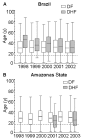Dengue and dengue hemorrhagic fever, Brazil, 1981-2002
- PMID: 15705322
- PMCID: PMC3294356
- DOI: 10.3201/eid1101.031091
Dengue and dengue hemorrhagic fever, Brazil, 1981-2002
Abstract
In the last 5 years, Brazil has accounted for approximately 70% of reported dengue fever cases in the Americas. We analyzed trends of dengue and dengue hemorrhagic fever (DHF) from the early 1980s to 2002 by using surveillance data from the Brazilian Ministry of Health. Two distinct epidemiologic patterns for dengue were observed: localized epidemics (1986-1993), and endemic and epidemic virus circulation countrywide (1994-2002). Currently, serotypes 1, 2, and 3 cocirculate in 22 of 27 states. Dengue and DHF affected mainly adults; however, an increase in occurrence of DHF among children has been recently detected in northern Brazil, which suggests a shift in the occurrence of severe disease to younger age groups. In 2002, hospitalizations increased, which points out the change in disease severity compared to that seen in the 1990s. We describe the epidemiology of dengue in Brazil, characterizing the changing patterns of it and DHF during the last 20 years.
Figures




Similar articles
-
Laboratory surveillance of dengue virus in Central Brazil, 1994-2003.J Clin Virol. 2006 Nov;37(3):179-83. doi: 10.1016/j.jcv.2006.07.004. Epub 2006 Sep 8. J Clin Virol. 2006. PMID: 16962821
-
Clinical characteristics of dengue and dengue hemorrhagic fever in a medical center of southern Taiwan during the 2002 epidemic.J Microbiol Immunol Infect. 2006 Apr;39(2):121-9. J Microbiol Immunol Infect. 2006. PMID: 16604244
-
Four dengue virus serotypes found circulating during an outbreak of dengue fever and dengue haemorrhagic fever in Jakarta, Indonesia, during 2004.Trans R Soc Trop Med Hyg. 2006 Sep;100(9):855-62. doi: 10.1016/j.trstmh.2005.11.010. Epub 2006 Feb 28. Trans R Soc Trop Med Hyg. 2006. PMID: 16507313
-
Global situation of dengue and dengue haemorrhagic fever, and its emergence in the Americas.World Health Stat Q. 1997;50(3-4):161-9. World Health Stat Q. 1997. PMID: 9477544 Review.
-
Dengue fever in the Western Hemisphere.Clin Lab Sci. 2003 Winter;16(1):34-8. Clin Lab Sci. 2003. PMID: 12587656 Review.
Cited by
-
Underreporting of Dengue-4 in Brazil due to low sensitivity of the NS1 Ag test in routine control programs.PLoS One. 2013 May 23;8(5):e64056. doi: 10.1371/journal.pone.0064056. Print 2013. PLoS One. 2013. PMID: 23717529 Free PMC article.
-
The history of dengue outbreaks in the Americas.Am J Trop Med Hyg. 2012 Oct;87(4):584-93. doi: 10.4269/ajtmh.2012.11-0770. Am J Trop Med Hyg. 2012. PMID: 23042846 Free PMC article.
-
Country- and age-specific optimal allocation of dengue vaccines.J Theor Biol. 2014 Feb 7;342:15-22. doi: 10.1016/j.jtbi.2013.10.006. Epub 2013 Oct 23. J Theor Biol. 2014. PMID: 24161462 Free PMC article.
-
Highly sensitive detection of dengue virus nucleic acid in samples from clinically ill patients.J Clin Microbiol. 2009 Apr;47(4):927-31. doi: 10.1128/JCM.01564-08. Epub 2009 Feb 18. J Clin Microbiol. 2009. PMID: 19225099 Free PMC article.
-
Epidemiological trends of dengue disease in Brazil (2000-2010): a systematic literature search and analysis.PLoS Negl Trop Dis. 2013 Dec 19;7(12):e2520. doi: 10.1371/journal.pntd.0002520. eCollection 2013. PLoS Negl Trop Dis. 2013. PMID: 24386496 Free PMC article.
References
-
- Pan American Health Organization. Surveillance–featured surveillance items. [cited 2003 Nov 23]. Available from http://www.paho.org/english/ad/dpc/cd/dengue.htm 2003
-
- Pinheiro FP, Corber SJ. Global situation of dengue and dengue haemorrhagic fever, and its emergence in the Americas. World Health Stat Q. 1997;50:161–9. - PubMed
-
- Pan American Health Organization. Directing Council Resolution CD43.R4. Washington: Pan American Health Organization. [cited 2003 Jun 2]. Available from http://Paho.org/English/GOV/CD/cd43_12-e.pdf
Publication types
MeSH terms
LinkOut - more resources
Full Text Sources
Medical
